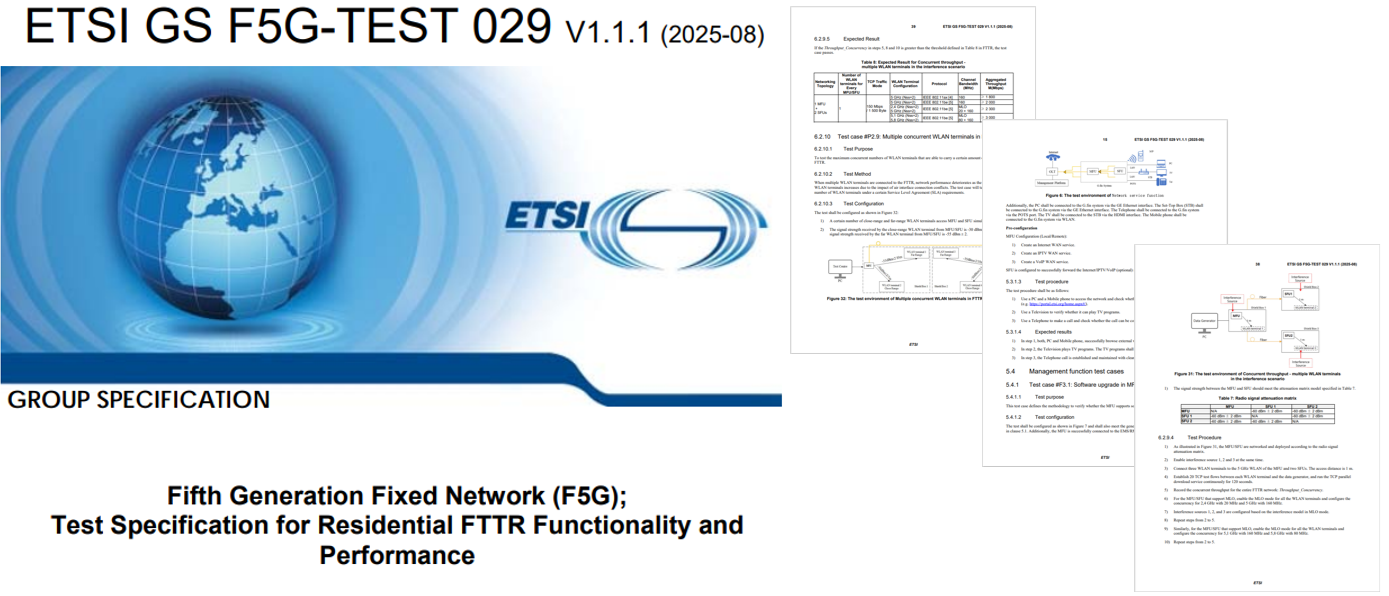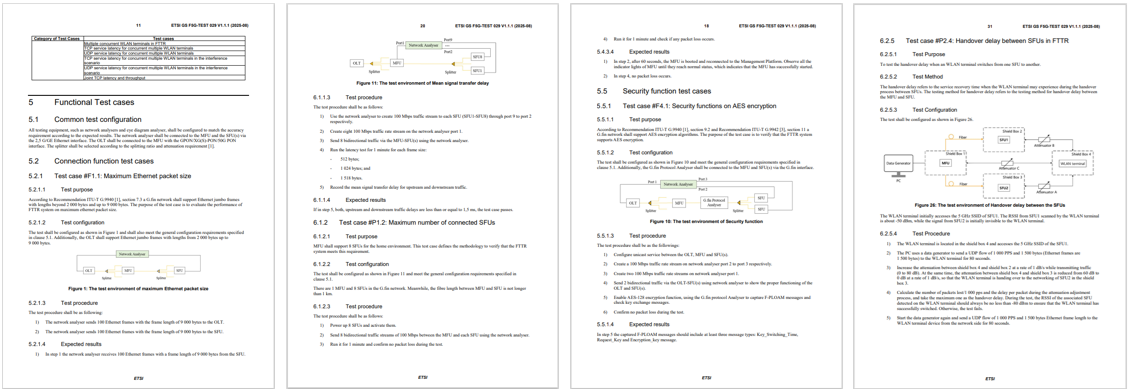Pioneering the Future of In-Home Connectivity: ETSI F5G ISG Publishes First Testing Work Item on FTTR
ETSI F5G ISG publishes its first Test WG Specification – "Test Specification for Residential FTTR Functionality and Performance", a landmark test specification for Fibre-to-the-Room (FTTR) functionality and performance. This crucial document establishes the global test standard for Fibre-to-the-Room (FTTR) systems, ensuring gigabit speeds, seamless roaming, and carrier-grade reliability for next-generation in-home networks. Discover how this specification paves the way for widespread, high-quality FTTR deployment.

We are excited to announce a significant milestone for the ETSI Industry Specification Group (ISG) Fifth Generation Fixed Network (F5G). The group has published its first specification from the F5G Test Working Group (TEST WG) - "Test Specification for Residential FTTR Functionality and Performance" (ETSI GS F5G 029).
Link to the specification: Fifth Generation Fixed Network (F5G): Test Specification for Residential FTTR Functionality and Performance.
This landmark publication marks a crucial step forward in standardising the assessment of next-generation fibre technologies, bringing much-needed clarity and consistency to the industry for Fibre-to-the-Room solutions.
A Closer Look at the Specification and Fibre-to-the-Room (FTTR)
What is FTTR?
Fibre-to-the-Room (FTTR) is an innovative, all-fibre solution that extends fibre optic cables directly from the main access point (the Main FTTR Unit or MFU) into every room of a home or office, terminating at Sub-FTTR Units (SFUs). Unlike traditional setups that use fibre to the home and then rely on copper Ethernet or Wi-Fi for internal distribution, FTTR provides a dedicated, high-bandwidth, low-latency fibre connection to each endpoint. This technology is essential for meeting the skyrocketing demands of modern applications like 4K/8K video streaming, cloud gaming, VR/AR, and extensive smart home ecosystems, ensuring a seamless, gigabit experience in every corner.
Scope of the Specification
The newly published Group Specification provides a comprehensive and standardised framework for testing the functionality and performance of FTTR systems based on ITU-T G.fin technology. Its extensive scope covers:
- Functional Testing: Verifying core capabilities such as connection establishment, network service support (Internet, IPTV, VoIP), device management (e.g., remote software upgrades, reboots), and security functions (AES and SM4 encryption).
- Physical Layer Performance: Defining test methodologies for critical optical link parameters, including signal transfer delay, optical link budget, and interface specifications for both upstream and downstream directions.
- WLAN Performance: Providing rigorous test cases for Wi-Fi performance, a critical user-facing aspect. This includes testing for self-recovery capabilities, seamless handover between MFU and SFUs, concurrent throughput for multiple users, and service latency under various conditions, including interference scenarios.

The Value of the Specification to the Industry
The publication of this test specification is more than just a technical document; it is a key enabler for the entire fibre ecosystem.
- Accelerating Commercial Deployment: A common, internationally recognised test standard eliminates ambiguity for manufacturers and operators. It streamlines the product development, qualification, and certification processes, which directly facilitates faster and wider commercial deployment of reliable FTTR solutions.
- Ensuring Quality and Reliability: Service providers and consumers can be confident that FTTR devices conforming to this specification will deliver the superior, wire-like performance and robustness required for premium broadband services. It sets a clear benchmark for what constitutes a high-quality FTTR system.
- Fostering a Healthy Ecosystem: Standardised testing lowers the barrier to entry for new vendors, promotes multi-vendor interoperability, and drives competition and innovation in the market, ultimately benefiting the end-user.
What's Next for F5G-A Testing?
The publication of the specification is just the beginning. The F5G Test Working Group is already building on this momentum with an ambitious roadmap to develop a comprehensive suite of test specifications. Our focus will expand from the in-home network to the broader F5G ecosystem, ensuring reliability and performance across all domains.
The upcoming Work Items currently in our pipeline include:
- DGS/F5G-0030: Test Specification for 50G PON Functionality and Performance – Defining test methodologies for the next generation of ultra-high-speed fibre access.
- DGS/F5G-0034: Test Specification for PON Based Industrial Network – Addressing the rigorous reliability and determinism requirements for using Passive Optical Networks in industrial and enterprise settings.
- DGS/F5G-0035: Test Specification for fgOTN Functionality and Performance – Establishing test standards for F5G-optimised Optical Transport Networks, which form the robust backbone for all F5G services.
- DGR/F5G-0041: F5G-A Methodology for Hybrid Measurement and Simulation of FTTR – Developing advanced methodologies that combine real-world measurements with simulations to predict and optimise FTTR network performance more efficiently.
More details can be found here: F5G TEST: Work Programme.
By pursuing this roadmap, the F5G ISG continues to drive innovation and ensure that the entire fibre ecosystem, from the core network to the user's device, is built on a foundation of proven, interoperable, and high-performing technology.
We invite all industry stakeholders, manufacturers, service providers, testing laboratories, and researchers to join the group and contribute to the future of the F5G Group and contribute to the industry together.
You can access the complete ETSI GS F5G Specification "Fifth Generation Fixed Network (F5G); Test Specification for Residential FTTR Functionality and Performance" directly through the link below:
Fifth Generation Fixed Network (F5G): Test Specification for Residential FTTR Functionality and Performance.

